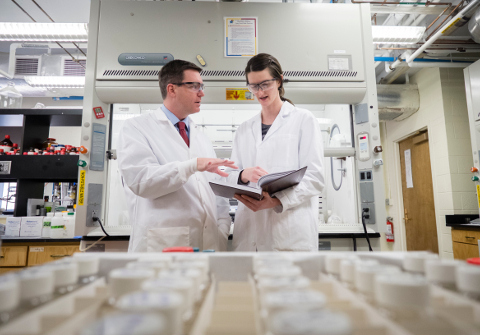HOME | ABOUT US | MEDIA KIT | CONTACT US | INQUIRE
HOME | ABOUT US | MEDIA KIT | CONTACT US | INQUIRE

Thomas Prisinzano, professor and chair of the Department of Medicinal Chemistry, works with a student in his lab. Photo by University of Kansas (source: Marcom)
LAWRENCE, Kan. — The rise of antibiotic-resistant diseases is frightening to contemplate, but a team of University of Kansas researchers has won an $11 million grant it hopes will help to find a solution.
The five-year grant from the National Institutes of Health will enable researchers on KU’s Lawrence campus to better contribute to the fight against infectious disease by studying fundamental biology with the use of small molecule chemical probes.
NIH funding will create a Center of Biomedical Research Excellence (COBRE): Chemical Biology of Infectious Disease. The grant was awarded to Thomas Prisinzano, professor and chair of the Department of Medicinal Chemistry. He is joined by Scott Hefty, associate professor in molecular biosciences.
“Our center is focused on developing chemical probes and strategies to better understand and treat infectious diseases. These efforts are especially significant with the rampant rise of antibiotic-resistant bacteria and the absent treatments for many emerging infectious diseases,” Prisinzano said.
The grant will bring together researchers from KU, KU Medical Center and Kansas State University. The grant places an emphasis on developing promising infectious disease research efforts of junior faculty members, Prisinzano said. In addition, the new center will establish three core facilities that can be utilized by researchers at KU and other universities:
While the grant to Prisinzano is for five years, it can be renewed for additional years. The Higuchi Biosciences Center at KU also hosts two other NIH-funded COBRE centers, both of which were renewed. The Center for Molecular Analysis of Disease Pathways, led by Susan Lunte, Department of Chemistry, is in its fifth year, and the Center in Protein Structure and Function, led by Robert Hanzlik, Department of Medicinal Chemistry, is in its 13th year.